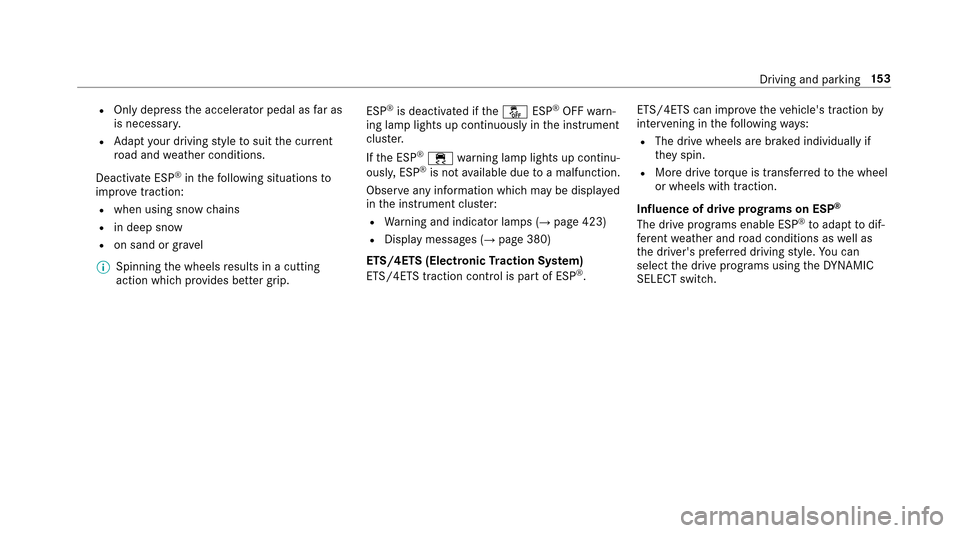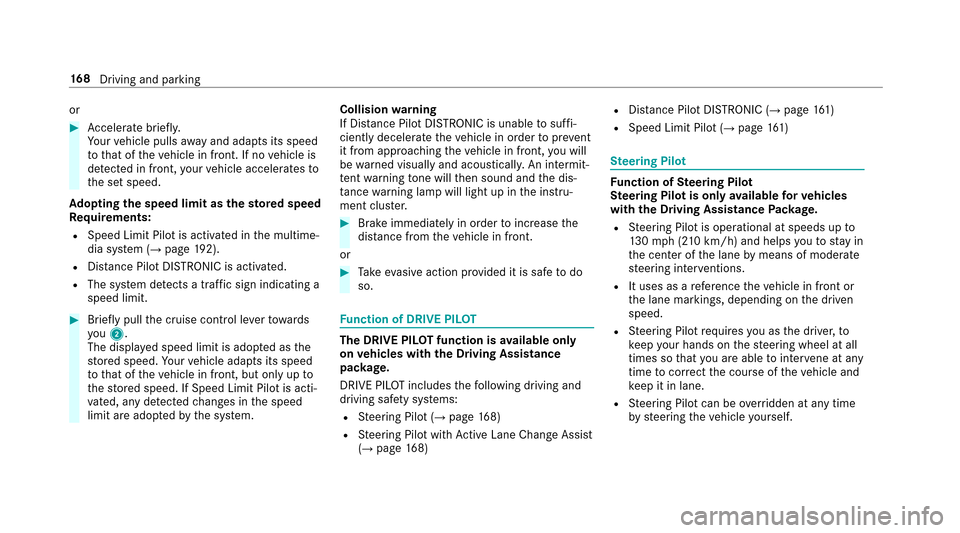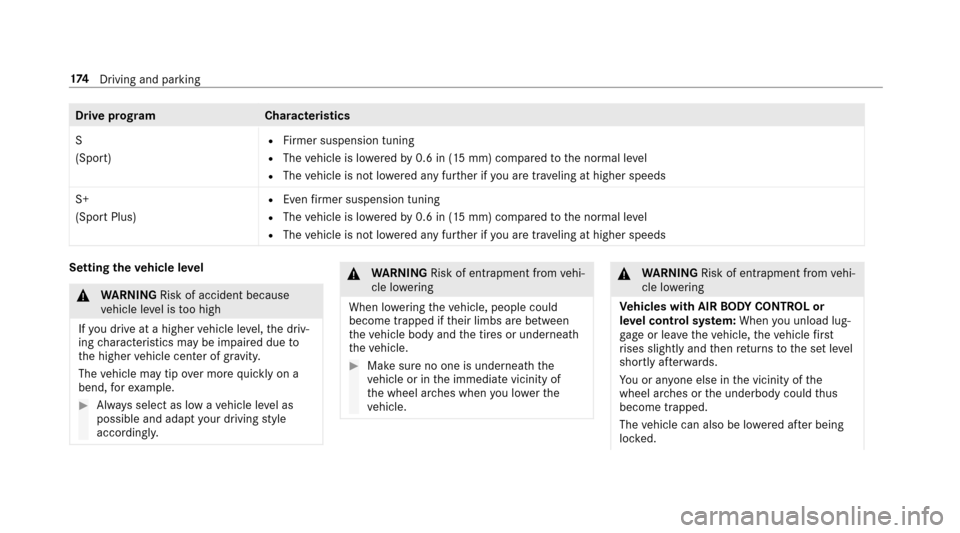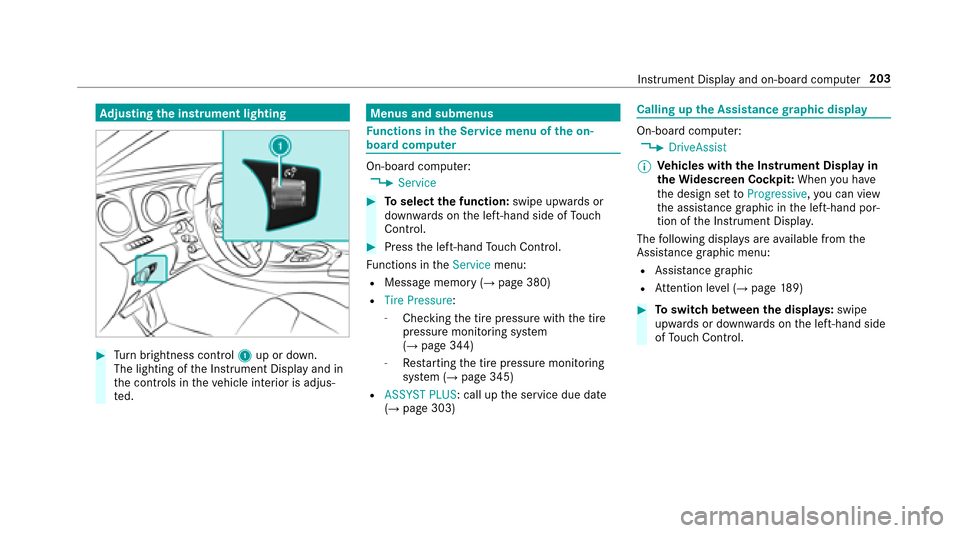2017 MERCEDES-BENZ E43AMG Light control
[x] Cancel search: Light controlPage 147 of 482

#Checkifth e transmit ter frequency of the
re mo tecontrol has the frequency range of
280 to868 MHz.
Ra dio equipment appr oval number:
RNZLMUA HL5 (USA)
R4112 A-MUAHL5 (Canada)
#Press and hold button 1,2or3 that you
wish toprog ram.
Indicator lamp 4flashes yello w.
% It can take up to20 seconds before the indi‐
cator lamp flashes yello w.
#Re lease the pr eviously pressed button.
Indicator lamp 4continues toflash yello w.
#Po int remo tecontrol 5at a dist ance of 1 in
(1 cm) to3 in (8 cm) towa rds buttons 1,2
or 3.
#Press and hold button 6ofremo tecontrol
5 until:
RIndicator la mp4lights up greencontin‐
uousl y.Programming is comple te.
RIndicator lamp 4flashes green. Pro‐
gr amming was successful. The rolling
code must also be synchronized with the
ga rage door sy stem.
#If indicator lamp 4does not light up or flash
green: repeat the procedure.
#Re lease all of the buttons. %
The remo tecontrol forth ega rage door drive
is not included in the scope of delivery of the
ga rage door opener.
Synchronizing thero lling code
Re quirements
RThe garage door sy stem uses a rolling code.
RThe vehicle must be within range of the
ga rage door or exterior gate drive.
RThevehicle as well as persons and objects,
are located outside the sweep of thega rage
door.
Driving and parking 14
5
Page 153 of 482

associated damage, which may not be visible,to
th e bumpers or radiator grille, ha vethe function
of thera dar sensors checked at a qualified spe‐
cialist workshop. The driver assis tance sy stem
may no longer workproperly.
Overview of driving and driving saf ety sys‐
te ms
In this section, youwill find information about
th efo llowing driving sy stems and driving saf ety
sy stems:
R360° Camera (→page 181)
RABS ( Anti-lock Braking Sys tem) (→page 151)
RDis tance Pilot DISTRONIC (→pa ge 161)
RAIR BODY CONTROL (→page 172)
RAc tive Brake Assi st(→page 155)
RAc tive Lane Keeping Assist (→page 195)
RATTENTION ASSIST (→page 189)
RBA S (Brak eAssist System) (→page 151)
REBD ( Electronic Brakeforc eDistribution)
(→page 155)
RESP®(E lectronic Sta bility Pro gram)
(→page 152)
RDRIVE PIL OT(→page 168)
RHOLD fu nction (→page 171)
RSteering Pilot (→page 168)
RParking Pilot (→page 184)
RParking Assist PARKTRONI C (→page17 6)
RRe ar view camera (→page 179)
RCruis e control (→page 160)
RBlind Spot Assist andActive Blind Spot Assi st
(→page 193)
RTraf fic Sign Assist (→page191)
Fu nctions of ABS (anti-lock braking sy stem)
ABS regulates the brake pressure in critical driv‐
ing situations:
RDuring braking, the wheels are pr evented
from blocking, forex ample due tomaximum
full-s top braking or insuf ficient traction of the
tires.
RVe hicle steerability while braking is ensured.
RABS is active from speeds of appr ox. 5 mph
(8 km/h).
If ABS inter venes when braking, youwill feel a
pulsing in the brake pedal. The pulsating brake
pedal can be an indication of hazardous road
conditions and can ser veas a reminder totake
ex tra care while driving.
Sy stem limits
ABS may be impaired or may not function if a
malfunction has occur red and theye llow !
ABS warning lamp lights up continuously in the
instrument clus ter af terth e engine is star ted.
Fu nction of BAS (Brake Assist Sy stem)
&
WARNING Risk of an accident caused by
a malfunction in BAS (Brake Assist Sys‐
te m)
If BA S is malfunctioning, the braking dis tance
may increase in an eme rgency braking situa‐
tion.
Driving and parking 15
1
Page 154 of 482

#Depress the brake pedal with full forc e
in emer gency braking situations. ABS
pr eve nts the wheels from locking.
BA S suppo rts yo ur eme rgency braking situation
with additional brake forc e.
If yo udepr essthe brake pedal quickl y,BA S is
acti vated:
RBA S au tomatical lyboosts the brake pres‐
sure.
RBA S can short enthe braking dis tance.
RABS pr events the wheels from locking.
The brakes will function as usual once you
re lease the brake pedal. BAS is deactivated.
Functions of ESP®(Electronic Stability Pro‐
gr am)
&
WARNING Risk of skidding if ESP®is
malfunctioning
If ESP
®is malfunctioning, ESP®cannot car ry
out vehicle stabilization. In addition, other
driving saf etysy stems are switched off.
#Drive on carefull y.
#Have ESP®checked at a qualified spe‐
cialist workshop.
&
WARNING Risk of skidding if ESP®is
deactivated
If yo u deactivate ESP
®, ESP®cannot car ry
out vehicle stabilization.
#ESP®should only be deactivated in the
fo llowing situations.
ESP®monitors and impr oves driving stability and
traction, particular ly inthefo llowing situations:
RWhen pulling away on wet or slippe ryroads.
RWhen braking.
RIn stro ng sidewinds when you are driving
fast erthan 50 mph (80 km/h).
ESP
®can stabilize theve hicle byinter vening in
th efo llowing ways:
ROne or more wheels are braked.
RThe engine output is adap ted according to
th e situation.
ESP
®is deactivated if the ESP®OFF å warn‐
ing lamp lights up continuously in the instrument
clus ter:
RDriving stability will no longe r be improved.
RCrosswind Assist is no longer active.
RThe drive wheels could spin.
RETS/4ETS traction control is still active.
% Even when ESP
®is deactivated, you are still
assis tedby ESP®when braking.
ESP
®is inter vening if the ESP®÷ warning
lamp flashes in the instrument clus ter:
RDo not deacti vate ESP®.
15 2
Driving and pa rking
Page 155 of 482

ROnly depressthe accelera tor pedal as far as
is necessar y.
RAdapt your drivin gst yle to suit the cur rent
ro ad and weather conditions.
Deactivate ESP
®in thefo llowing situations to
impr ove traction:
Rwhen using snow chains
Rin deep snow
Ron sand or gr avel
% Spinning the wheels results in a cutting
action which pr ovides better grip. ESP
®is deactivated if
theå ESP®OFFwarn‐
ing lamp lights up continuously in the instrument
clus ter.
If th e ESP
®÷ warning lamp lights up continu‐
ousl y,ESP®is not available due toa malfunction.
Observ e any information which may be displa yed
in the instrument clus ter:
RWa rning and indicator lamps (→page 423)
RDisplay messages (→page 380)
ETS/4ETS (Electronic Traction Sy stem)
ETS/4E TStraction control is pa rtof ESP
®. ETS/4ETS can impr
ovetheve hicle's traction by
inter vening in thefo llowing ways:
RThe drive wheels are braked individually if
they spin.
RMore drive torque is transferred tothe wheel
or wheels with traction.
Influence of drive prog rams on ESP
®
The drive prog rams enable ESP®to adapt todif‐
fe re nt we ather and road conditions as well as
th e driver's prefer red driving style. You can
selec
t the drive prog rams using theDY NA MIC
SELECT switch.
Driving and parking 15
3
Page 165 of 482

play inthe Instrument Display is alw ays update d
when theve hicle is le vel with the traf fic sign.
If th e Dis tance Pilot DISTRONIC has been put
into passive modebypressing the accelerator
pedal, only speed limits which are higher than
th e set speed are adop ted.
Pulling the cruise control le ver will set the dis‐
pla yed speed limit as the speed, pr ovided that:
RThe Speed Limit Pilot has been activated in
the multimedia sy stem and
RDis tance Pilot DISTRONIC has been acti va‐
te d.
If no speed limit is displa yed when the le ver is
operated, the speed set bythe driver is adop ted.
Drive prog ram
The DYNA MIC SELECT switch allo wsyouto
ch ange the driving style of Dis tance Pilot
DISTRONIC. Depending on which drive program
is selected, the driving characteristics can be
ge ared towa rds fuel econom y,comfort or
dynamic per form ance (
→page 136). Sy
stem limits
Ve hicles with the Driving Assistance Pack‐
age: Distance Pilot DISTRONIC is acti veinthe
0 mp h (0 km/h) to130mp h (2 10km/h) speed
ra nge.
The sy stem may be impaired or may not function
in thefo llowing situations:
RIn sno w,rain, fog, heavy spr ay, if there is
gl are, in dir ect sunlight or in greatly varying
light conditions.
RIf th e windshield in the area of the camera is
dirty, fogged up, damaged or co vered.
RIfth era dar sensors are dirty or co vered.
Do not use Dis tance Pilot DISTRONIC in thefo l‐
lowing situations:
RIn road and traf fic conditions whi chdo not
allow youto maintain a cons tant speed, e.g.
in heavy traf fic or on winding roads.
ROn slippery roads. Braking or accelerating
can cause the drive wheels tolose traction
and theve hicle could then skid.
RWhen there is poor visibility, e.g. due tofog,
heavy rain or sno w.
RIn parking garage s or at tollst ations.
ROn roads with steep uphill or downhill gradi‐
ents.
Tips
Pa yparticula rattention in thefo llowing traf fic
situations. In such situations, brake if necessar y.
Dis tance Pilot DISTRONIC is then deactivated:
RWhen cornering, entering and exiting a bend.
RWhen not driving in the center of the lane.
RWhen other vehicles are changing lane.
RIfth ere are nar rowvehicles.
RIfth ere are obs tacles and stationary vehi‐
cles.
RIf th ere are crossing vehicles, pedestrians,
mo torcyc lists or cyclists.
Driving and parking 16
3
Page 170 of 482

or
#Accelerate brie fly.
Yo ur vehicle pulls away and adapts its speed
to that of theve hicle in front. If no vehicle is
de tected in front, your vehicle accelerates to
th e set speed.
Ad opting the speed limit as thesto red speed
Re quirements:
RSpeed Limit Pilot is activated in the multime‐
dia sy stem (→page 192).
RDis tance Pilot DISTRONIC is acti vated.
RThe sy stem de tects a traf fic sign indicating a
speed limit.
#Brie fly pull the cruise control le verto wa rds
yo u2.
The displ ayed speed limit is adop ted as the
st ored speed. Your vehicle adapts its speed
to that of theve hicle in front, but only up to
th estored speed. If Speed Limit Pilot is acti‐
va ted, any de tected changes in the speed
limit are adop tedby the sy stem. Collision
warning
If Dis tance Pilot DISTRONIC is unable tosuf fi‐
ciently decele rate theve hicle in order topreve nt
it from approach ingtheve hicle in front, you will
be warned visually and acousticall y.An intermit‐
te nt wa rning tone will then sound and the dis‐
ta nce warning lamp will light up in the instru‐
ment clus ter.
#Brake immediately in order toinc rease the
dis tance from theve hicle in front.
or
#Ta ke evasive action pr ovided it is safe todo
so.
Fu nction of DRIVE PIL OT
The DRIVE PILOT function isavailable only
on vehicles with the Driving Assistance
pa ckage.
DRIVE PIL OTincludes thefo llowing driving and
driving saf etysy stems:
RSt eering Pilot (→page 168)
RSteering Pilot with Active Lane Change Assi st
(→page 168)
RDis tance Pilot DISTRONIC (→pa ge 161)
RSpeed Limit Pilot (→page161)
Ste ering Pilot
Function of Steering Pilot
Ste ering Pilot is only available forve hicles
with the Driving Assistance Package.
RSteering Pilot is operational at speeds up to
13 0mp h (2 10km/h) and helps youto stay in
th e center of the lane bymeans of moderate
st eering inter ventions.
RIt uses as a refere nce theve hicle in front or
th e lane markings, depending on the driven
speed.
RSt eering Pilot requ ires you as the driver, to
ke ep your hands onthesteering wheel at all
times so that you are able tointer vene at any
time tocor rect the course of theve hicle and
ke ep it in lane.
RSteering Pilot can be overridden at any time
by steering theve hicle yourself.
16 8
Driving and pa rking
Page 176 of 482

Driveprog ramC haracteristics
S
(Sport)
RFirmer suspension tuning
RThe vehicle is lo weredby 0.6 in (15 mm) compared tothe normal le vel
RThe vehicle is not lo wered any fur ther if you are tr aveling at higher speeds
S+
(Sport Plus)
REven firm er suspension tuning
RThe vehicle is lo weredby 0.6 in (15 mm) compared tothe normal le vel
RThe vehicle is not lo wered any fur ther if you are tra veling at higher speeds
Setting theve hicle le vel
&
WARNING Risk of accident because
ve hicle le vel is too high
If yo udriv e at a higher vehicle le vel,th e driv‐
ing characteristics may be impaired due to
th e higher vehicle center of gr avity.
The vehicle may tip over more quickly on a
bend, forex ample.
#Alw ays select as low a vehicle le vel as
possible and adapt your drivin gst yle
accordingl y.
&
WARNING Risk of entrapment from vehi‐
cle lo wering
When lo wering theve hicle, people could
become trapped if their limbs are between
th eve hicle body and the tires or underneath
th eve hicle.
#Make sure no one is underneath the
ve hicle or in the immediate vicinity of
th e wheel ar ches when youlowe rth e
ve hicle.
&
WARNING Risk of entrapment from vehi‐
cle lo wering
Ve hicles with AIR BODY CONT ROL or
le ve l control sy stem: When you unload lug‐
ga ge or lea vetheve hicle, theve hicle firs t
ri ses slightly and then returns tothe set le vel
shortly af terw ards.
Yo u or an yone else in the vicinity of the
wheel ar ches or the underbody could thus
become trapped.
The vehicle can also be lo wered af ter being
loc ked.
17 4
Driving and pa rking
Page 205 of 482

Adjusting the in stru ment lighting
#Turn brightness control 1up or down.
The lighting of the Instrument Display and in
th e controls in theve hicle interior is adjus‐
te d.
Menus and submenus
Fu nctions in the Service menu of the on-
board compu ter
On-board computer:
,�6�H�U�Y�L�F�H
#To select the function: swipe upwards or
down wards on the left-hand side of Touch
Control.
#Press the left-hand Touch Control.
Fu nctions in the�6�H�U�Y�L�F�H menu:
RMessage memory (→page 380)
R�7�L�U�H �3�U�H�V�V�X�U�H :
-Checkingthe tire pressure with the tire
pressure monitoring sy stem
(
→page 344)
-Re starting the tire pressure monitoring
sy stem (→page 345)
R�$�6�6�<�6�7 �3�/�8�6: call up the service due date
(→page 303)
Calling up the Assistance graphic display
On-board computer:
,�'�U�L�Y�H�$�V�V�L�V�W
% Ve
hicles with the Instrument Display in
th eWi descreen Co ckpit: When you ha ve
th e design set to�3�U�R�J�U�H�V�V�L�Y�H ,yo u can view
th e assis tance graphic in the left-hand por‐
tion of the Instrument Displa y.
The following displa ysare available from the
Assist ance graphic menu:
RAssistance graphic
RAt tention le vel (→page 189)
#To switch between the displa ys:swipe
up wa rds or down wards on the left-hand side
of Touch Control.
Instru ment Display and on-board computer 203